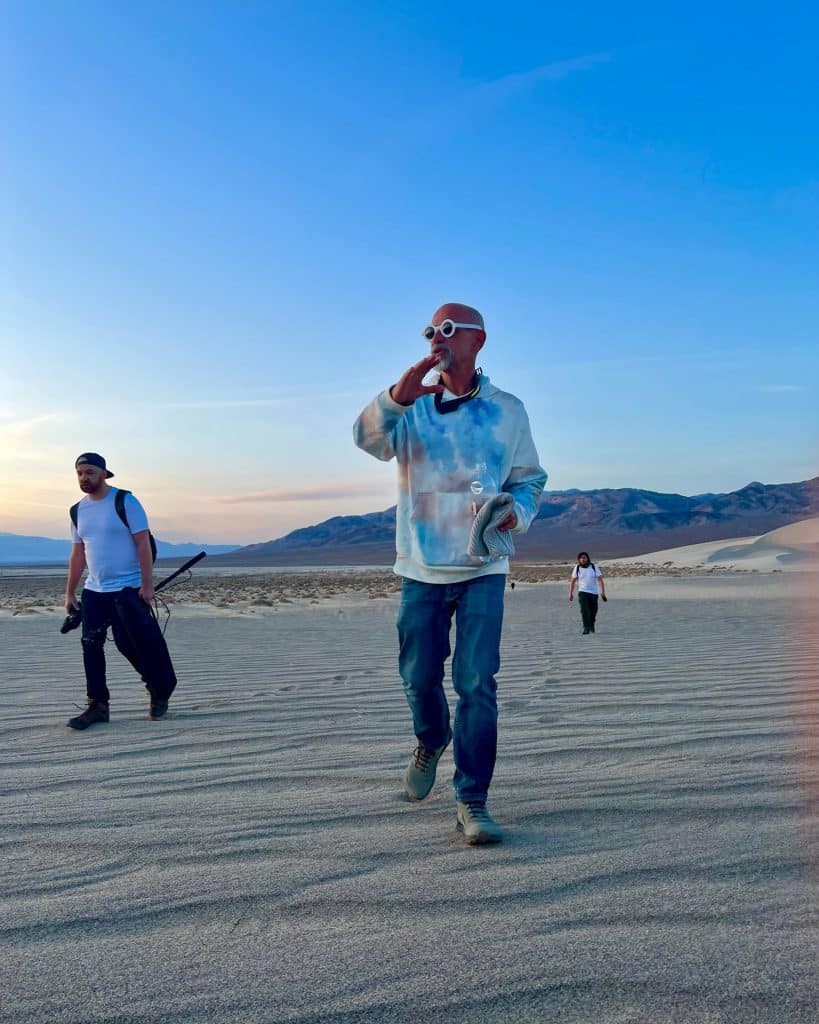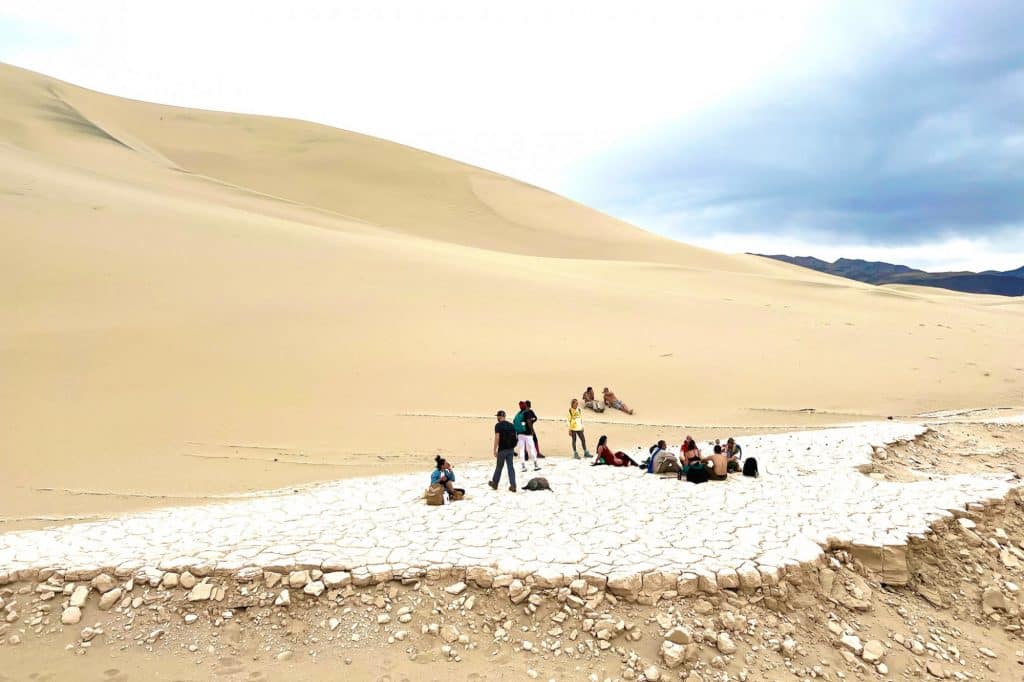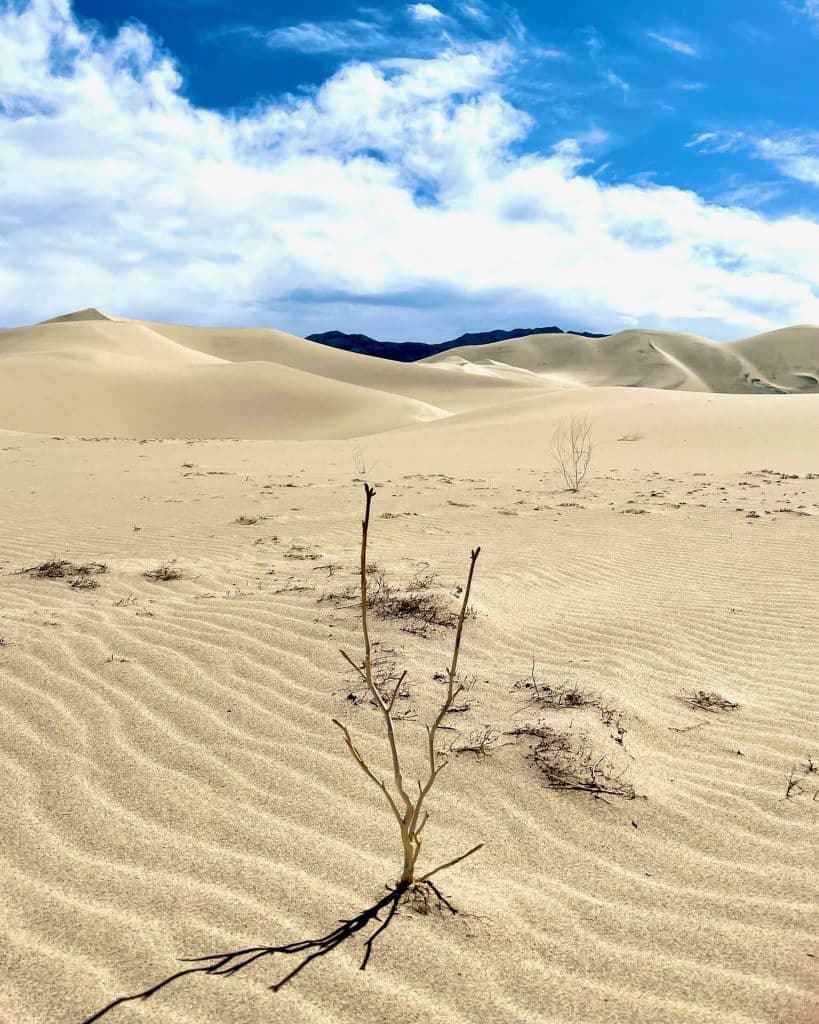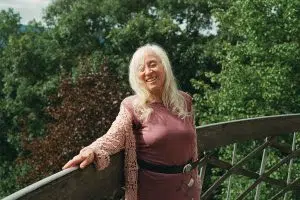Karen Hoekstra had never tried psychedelics before the moment she was walking hand-in-hand with her four-year-old self amongst the Eureka Dunes in Death Valley National Park. Rolling hills of sand appeared like naked bodies intertwined; deep, vibrational groans emanated from the dunes, a mystery scientists call “singing sand;” and the weathered faces of the Last Chance Mountains, boldly striped with black, gray, and pink, jutted skyward. She walked to the peak of a dune, where a vision of her husband and four kids were waiting in an orb of yellow light to celebrate how far she’s come. “It was like three years of therapy in one afternoon,” she recalls.
Hoekstra, 43, who grew up in a strict, by-the-bible household, was among a group of strangers, myself included, brought together to experience this three-night retreat that combined nature, psychedelics, and human connection. Organized by The Mind Army—a nonprofit with the mission of “fighting for the right to pursue happiness”—and Vision Treks, an organization that curates these sorts of entheogenic journeys, the founders of both organizations, Zappy Zapolin, Kaia Roman, and Atom Smith, oversaw the use of optional and legal psychedelics and plant medicines throughout the retreat, including rapé (pronounced “ha-peh;” a powdered tobacco snuff), cannabis, and a guided group ketamine session (ingested orally), after attendees obtained a prescription from a doctor. Each of the founders have been working with psychedelic medicine for many years, and have guided psychedelic journeys for nearly 2000 people combined. Additionally, Atom studied neuropsychopharmacology in college and has been studying Indigenous plant medicine since 2016, whereas Zapolin and Roman (along with Warren Gumpel) co-founded the at-home ketamine treatment company KetaMD.
READ: Are Ketamine Clinics Paving the Way for Legal Psychedelic Therapy?

At first, Hoekstra wasn’t sure if she would partake in these substances (the sublime trek alone made the travel worthwhile), but it was the connection of this unlikely group of CEOs, scientists, writers, and athletes—people she would have otherwise never met—that ultimately convinced her that she would be safe and supported throughout the process. After years of struggling with abandonment issues, Hoekstra was ready to dive into the unknown.
“When you take your next vacation, don’t go to a regular place. Go into nature and go inward, but surrounded by people,” says Zapolin of Vision Treks, adding that the benefit of tripping with a group away from home provides exposure to a new environment and new friends to integrate with afterward. “If you choose to go to a clinic, but the people administering the medicine haven’t experienced psychedelics themselves, you’re at the wrong clinic.”
This opinion gets to the heart of a debate unfolding within the psychedelic movement now as it grows—who should be administering psychedelic medicines and what’s the best environment in which to take them?

As part of the global wellness industry, psychedelic medicine was valued at about $2 billion in 2019, and is expected to reach more than $7 billion by 2027, according to a 2020 analysis from Data Bridge Market Research. On one side of the spectrum of aboveground offerings, there are clinics like Field Trip Health, where a visit to the spa-like space is similar to a therapist’s office, with the addition of ketamine-assisted therapy. Beond, an ibogaine treatment center in Cancún, Mexico, represents the rehabilitation facility model, where guests receive holistic, personalized care over an extended period of time in a tranquil setting. Finally, psychedelic retreats—which are relatively easy to come by in countries like Jamaica, Mexico, Costa Rica, and the Netherlands—offer experiences only limited by a participant’s proclivity for adventure, be it purging on a yoga mat in the depths of the Amazon to pristine ocean-front properties. They’re also often contingent upon a person’s willingness or ability to spend, with prices varying, on average, from $5,000 to $10,000 for a week or longer (some retreats offer reduced-fee scholarship programs). Another important consideration is who a person wants guiding the experience (lab coats, Indigenous shamans, or something in the middle).
READ: How to Vet Your Guide

Despite the chipping away at the decades-long stigma around psychedelics leading to aboveground training and research (the farthest along is the Multidisciplinary Association for Psychedelic Studies’ phase 3 trials of MDMA- assisted psychotherapy for the treatment of PTSD), the underground has also maintained a strong following. The process of waiting for FDA approval is frustratingly slow for many guides whose credibility doesn’t depend on a governing body or a doctor’s ability to write a prescription, rather their reputation precedes. One such practitioner, a hypnotherapist of 15 years who has facilitated LSD, MDMA, and psilocybin medicine ceremonies for five years, and requested to remain anonymous for legal reasons, says the underground—which she equates to having a private practice—offers flexibility (“we’re in an exploratory phase”). The aboveground, in contrast, she says skews toward law and rigidity, something inherently limited, and therefore, counterintuitive to working with plant consciousness (“they have an intelligence of their own”). Knowledge-sharing and mentorship is a big part of the underground network, as is thorough screening of potential clients; strict protocol is not. That may change, however, as more abuses of power and sexual assault allegations in psychedelic therapy come to light both above and underground, calling for added measures to prevent harm.
How to Grow Shrooms Bundle
Take Both of Our Courses and Save $90!
One area where underground practitioners might consider themselves at an advantage is their ability to dose how they see fit and mix medicine—a consideration that makes many classically-trained psychiatrists and newly-credentialed therapists cringe. Does it help to have some academic knowledge, including the history of the medicine and an understanding of physiological reactions? Yes, says the underground practitioner—and after a brief pause—but being a good facilitator comes with embodied experience, not intellect. “You’ll only be able to go deep with someone if you’ve gone deep yourself.” The idea that someone who is certified with no real-world experience is more qualified than a facilitator who has been working with psychedelics for years, doesn’t seem accurate, she adds.

Ronan Levy, co-founder of Field Trip, adamantly disagrees. “I’ve worked with people who have never experienced psychedelics or haven’t in 30 years, whose capability to support someone through a psychedelic experience, I would argue, is far superior to even the most experienced guides,” he says.
A pilgrimage is said to be a search for meaning, purpose, values, or truth. For the group wandering the desert, the amount of space given to each person to allow their own journeys to unfold became the testament to the facilitators’ expertise. “They didn’t impose themselves on the experience,” says Hoekstra. Instead, they let nature do its work.
Occasionally, an eagle could be seen flying above. I imagined, from its perspective, each human appearing like a small, solitary dot— sitting on the sandy slopes, running from one peak to another, or slowly traversing the valley. Eventually, the group came back together and gathered on a cracked, salty patch of earth—a dried basin surrounded by dunes. It was the freedom to wander off alone and then choose to come back to the group that made the experience for Hoekstra. “I don’t think I would have been able to fully surrender if someone was beside me the whole time,” she says. “I needed to wander off by myself and be on my own, but then also feel the safety of knowing the group was there to come back to. Even as we were wandering, you would fall into conversation casually with people, then disperse again. It was like little stops along the way for connection before going back into your own thoughts.”

Charley Wininger, licensed psychotherapist and author of “Listening to Ecstasy: The Transformative Power of MDMA,” along with his wife Shelley, has been leading similarly unstructured MDMA gatherings with upwards of 40 people, ages 20-75, at Prospect Park in Brooklyn, New York for the past few years. There is no money exchanged; no ceremony; it isn’t focused on healing. According to those deterred by the use of psychedelics outside of a strictly clinical setting, this scenario is risky. If that’s the case, it’s a risk that Wininger is willing to take, although he says there have never been safety issues with his approach.
“At this time in our culture’s history, with so much isolation, loneliness, and alienation, we have a crying need for connection. Getting people together, bonding [through heart-opening compounds], and feeling a sense of community, can last in a sober way for months and years to come,” he says. Referencing a chapter in his book, “A Guide to the Responsible Recreational Use of MDMA,” Wininger provides a step-by-step guide for working with MDMA solo, as a couple or in a group setting, telling me that anyone can host their own gathering with proper preparation. “We start in a circle, set the ground rules around safety and boundaries, and then everybody just walks about the park or apartment,” he says. From the outside, it looks like a bunch of adults having a nice day.
Levy cautions against just letting strangers have these experiences together. He says the wrong mix of people can create an environment where participants do not feel capable of doing the healing they set out to do and may even be harmed. “As a simple hypothetical example,” he says, “a female survivor of sexual trauma being placed in a group with five burly men is probably not a great dynamic.” The value of individualized therapy in a clinical setting or one-on-one with an underground practitioner eliminates this variable, along with the ability to achieve a level of depth that might not be possible in a group, where attention is divided and individuals are largely left to navigate challenges on their own.
READ: I Love You—Let’s Trip Together

On the other hand, Justin Townsend, CEO of MycoMeditations, which has operated legal psilocybin-assisted retreats in Jamaica since 2014, says the benefits of a group retreat is that sharing and hearing about other people’s experiences and reasons for being there helps break through the sense of isolation that so many people feel when experiencing their own mental health condition. In a survey, published in the Journal of Psychopharmacology, of almost 2,000 people who had challenging experiences after ingesting psilocybin outside of a clinical context, 39 percent reported the experience to be among the five most challenging events of their lifetime. In spite of these challenging experiences, 84 percent of respondents reported positive, long-term effects.
But what happens if someone in the group has a “bad trip,” where, for instance, they begin screaming? Does it impact everyone negatively? Deanna Rogers, a practitioner training specialist with Numinus who previously worked at the Temple of the Way of Light facilitating ayahuasca ceremonies, is passionate about helping underground therapists to become more rigorous with their screening protocols. She says it’s important to go into a group ceremony knowing that it’s a possibility to be impacted by others, but to use that as an opportunity to get curious about what’s being activated. “I know that if someone is having a big experience, a lot of Westerners working with these medicines will take them out of the ceremony,” she says, something that she has never seen happen while working with Indigenous healers. “The medicine is there to open people up, and the dosage is such that they can focus and work with the feelings. If it’s anger, fear, grief, or a desire to run away, get curious and do an inquiry process.” She advises people to trust what they feel called to and what risk they’re willing to take, whether it’s a two-week immersive experience at a retreat or a three-hour ketamine session at a clinic close to home.

As interest and accessibility intersect, a growing number of people are sitting down at their computers to Google “how to find a psychedelic retreat” (clinic or rehab center). Tom Feegel, founder and CEO of Beond, says there are three types of people who are seeking a therapeutic interaction with psychedelics, and depending on their needs, would benefit most from a clinic, rehabilitation center, or retreat. The first group of people has a health-specific problem such as a chemical dependency, clinical depression and/or anxiety, post-traumatic stress disorder, or traumatic brain injury. They have typically gone the route of conventional rehab to no avail.
“When they finally get to us, they have an assumption that they’re seeking medical help,” he says. They want the look and feel of a clinic, including doctors, nurses, licensed psychotherapists, nutritionists, and board-certified addiction medicine specialists. Often, success feels like a matter of life or death. According to Feegel, the second group is considered “resetters.” They might have an obsession with media, their phone, work, sex, or food, and “just want to reset their relationship to reality, and have it stick,” he says. “We believe all of these behaviors are maladaptive, self-motivated treatments for trauma.” The third group likely self-identifies as peak performers who have plateaued. Success isn’t overcoming addiction, but shaving a second off their personal best or seeing the reason for their chosen profession or passion with newfound clarity.
READ: How to Choose the Right Ayahuasca Retreat for You

Hoekstra’s mantra going into the retreat was “surrender.” As a self-identified “control freak,” this was no easy task, especially since she had never done anything remotely like it before. The immensity of the dunes and the relentless heat put her at the mercy of nature. “I can’t imagine a more perfect setting,” she says. So vastly different from her everyday life, there was no choice but to be shaken from her typical thoughts. Although she didn’t go into the experience necessarily knowing what she was looking for, she knew she was finally ready to receive whatever came her way.
Townsend’s advice, when you feel called to a psychedelic experience, is to do your research with a guiding question: Why do you want to have this experience?
“It’s important to have as much information as possible to make an informed decision about the type of care you wish to receive to achieve the desired result for your specific condition,” he says. “Some questions to ask the retreats you are considering include: what is the ratio of staff members to guests; what are the qualifications, licensing, and experience of the staff on retreat; how many doses of psilocybin are administered during the retreat; is the retreat company experienced in working with high doses of psilocybin; and is there any therapeutic support and community for guests after the retreat?”
Those last three words, he says, are key: after the retreat.
Neil Markey—a former C-Suite executive and Special Ops Captain in the US Army who turned to plant medicine to transform his life-now runs Beckley Retreats, a psilocybin-focused holistic wellness program created by the renowned drug policy reform and scientific research institution, Beckley Foundation. He says one of the biggest issues with many retreats is that they give people peak, mystical experiences, and then there’s no follow-up. Beckley Retreats’ first gathering, which took place in Jamaica in 2022, included a four-week virtual lead-up program, a five-night retreat, and six weeks of digital integration.

Therapists and researchers widely agree that integration is a key component of effective psychedelic work, regardless of whether a person trips alone, at a retreat center, or at a clinic—but it’s not so simple. Ingmar Gorman, co-founder of Fluence, a psychedelic education company training mental health providers in psychedelic treatments, says that in the “average” integration circle, the assumption is that people speaking out loud and sharing what happened is the healing. “But it’s not necessarily the case, and it can be kind of superficial,” he says. “Not to say that people taking turns talking in a circle is not significant, but it’s different than a trained therapist who is facilitating what’s called a ‘group process.’” The therapist’s role, he says, is to tease out the individual’s experiences as potentially illuminating for the group, and use the group’s dynamic, which might involve moments of tension, to facilitate clarity of self through relation to others.
How to Grow Shrooms Bundle
Take Both of Our Courses and Save $90!
Markey says it’s essential to have this kind of support in the wake of a psychedelic retreat or it’s common for people to return to their jobs, family, bills, demands, frustrations, indulgences, and so on and struggle to make sense of or assimilate the lessons they learned. “Old habits die hard and the environments we’re accustomed to have momentum,” he says. His dream is to create cohorts outside of the retreats, where people can get together and do things that aren’t alcohol-related. “A lot of what we’re trying to fix right now is some form of disconnection,” he says. “How do we get more people connected with good humans and back in nature?”

Roman (of Vision Treks) says when people are distracted by texts and tasks, they don’t notice the messages from nature trying to come through. Sometimes, challenging environmental conditions, like dunes and blistering heat, paired with what she calls a “cosmic state,” provide the perfect opportunity to surrender—mentally and physically.
It’s six in the morning and dead quiet at the track by Hoekstra’s house in British Columbia, Canada. She is out on a run, but can’t seem to outpace the familiar anxiety-ridden ruminations about abandonment—things she thought she’d overcome in the desert a few weeks back. Then, suddenly, she stops in her tracks with an acute feeling that someone is tugging on her arm. It’s her four-year-old self. The morning chill vanishes and the desert comes rushing back: She can feel the sun on her face, remembering what it was like to proudly walk hand-in-hand over the dunes. “At that moment, I had a realization: I can’t be abandoned because I’m at a point where I’ll never abandon myself again.” She jogged the rest of the way home in peace.
*This article was originally published in DoubleBlind Issue 8.

DoubleBlind is a trusted resource for news, evidence-based education, and reporting on psychedelics. We work with leading medical professionals, scientific researchers, journalists, mycologists, indigenous stewards, and cultural pioneers. Read about our editorial policy and fact-checking process here.

DoubleBlind Magazine does not encourage or condone any illegal activities, including but not limited to the use of illegal substances. We do not provide mental health, clinical, or medical services. We are not a substitute for medical, psychological, or psychiatric diagnosis, treatment, or advice. If you are in a crisis or if you or any other person may be in danger or experiencing a mental health emergency, immediately call 911 or your local emergency resources. If you are considering suicide, please call 988 to connect with the National Suicide Prevention Lifeline.



